Dosemeters - Dose Assessment Services
In this section
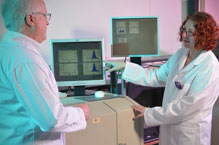
Comprehensive, Simple and Effective
This page describes our dose measurement, or assessment, services. These are all based on personal radiation dosemeters (sometimes called "badges"). We provide a variety of these dosemeters, covering a comprehensive range of measurement needs. Our aim is to keep the design of our dosemeters simple, so that they can respond correctly, whatever the exposure situation, without the need for further information or complex algorithms.
A Quality Service
Our individual dosimetry services meet exacting quality standards, and are approved by the UK Health and Safety Executive under the Ionising Radiations Regulations 2017. In addition to this, our customers receive excellent care from our dedicated Customer Services team and have access to expert advice on personal dosimetry. And, if an emergency occurs we can read your dosemeters quickly at our UK-based laboratories, at no extra charge.
TLDs (Thermoluminescent Dosemeters)
TLDs work by storing the energy they receive from the ionising radiation (e.g. gamma rays) until they are heated to a high temperature (around 250°C). When this happens, the energy is released as visible light. The light output is measured, and the result is proportional to the radiation dose received. All our TLDs use the high-sensitivity, tissue-equivalent material LiF:Mg,Cu,P (lithium fluoride, doped with magnesium, copper and phosphorus).
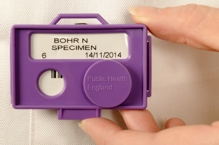
Body TLD
Our standard dosemeter is the body TLD. This is used for the vast majority of exposure situations, including veterinary and dental work, medical applications and non-destructive testing. It can be used for:
- measurements of whole body and skin doses from gamma, x- and beta radiations
- eye lens dose from gamma and x-rays
- routine, accident and emergency doses
Technical Datasheet - Body Thermoluminescent Dosemeter (TLD)
PDF format, 560 KB
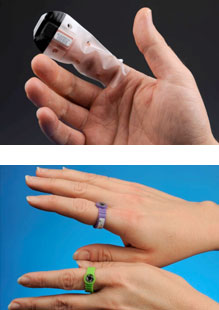
Extremity TLDs
These are used where the extremities (hands and feet) could get significantly more radiation dose than the rest of the body. They can be used for:
- measurements of extremity (skin) doses from gamma, x- and beta radiations
- routine and emergency doses
- rings, adjustable in size to suit a range of fingers - preferred when using gamma- or x-rays
- finger stalls, like the finger of a glove, in two sizes - preferred when using beta sources or close handling of sources
- ankle straps, for measuring doses to the feet.
They come in three formats:
Technical Datasheet - Extremity Dosemeter
PDF format, 572 KB
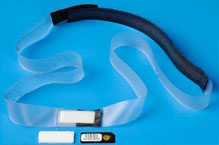
Headband (Eye Lens) Dosemeter
This dosemeter is recommended where the eyes can be exposed to beta radiations, or where gamma/ x-ray fields are non-uniform. It uses the same detector as the extremity finger stall, but is configured for the recommended measurement quantity for the eye lens. The head band allows the detector to be positioned either centrally on the forehead, or over the eye that is expected to receive the highest dose.
The headbands must be used with the white filter facing outwards and the bar code facing inwards. They are used for:
Technical Datasheet - Eye Dosemeter
PDF format, 672 KB
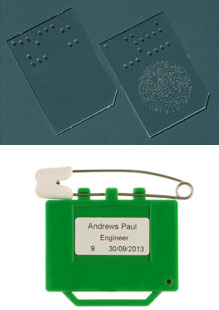
Neutron Dosemeters
Our neutron dosemeters use thin plastic elements to detect the protons that result from neutron interactions. The plastic is poly-allyl-diglycol carbonate (PADC, also known as "CR39") and an electro-chemical etching process is used to reveal the damage tracks left by the protons. These tracks, now visible as etched pits, are then counted by automatic image analysis. The number of pits is proportional to the neutron dose.
The neutron dosemeter is mainly used for nuclear industry applications, with some usage in the medical, research and industrial sectors. It can be used for:
- measurements of whole body and skin doses from neutron radiations
- routine and emergency doses
Technical Data Sheet - Neutron Dosemeter
PDF format, 668 KB
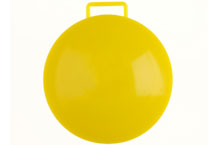
Radon Dosemeters
These are used in rare situations where, although radon levels are elevated, no cost-effective remediation measures are available. This is usually in underground workplaces. In these cases, individual workers have to be monitored to ensure that their doses are being kept to acceptable levels. The service is separate from standard radon measurement service for dwellings and workplaces. Visit www.ukradon.org. The radon dosemeter uses the same technology and same processing as the neutron dosemeter, although the holder is different.
The radon dosemeter is used for:
- measurements of committed effective dose from exposure to radon and its decay products
If you believe your workers are exposed to elevated radon levels and you would like advice, start by visiting the "UK Radon" site at the link above. In most cases, you will be able to do something about the radon levels, so take advice first. This advice note gives more detail.
Technical Datasheet - Radon Dosemeter
PDF format, 857 KB
Radon advice note
PDF format, 40 KB